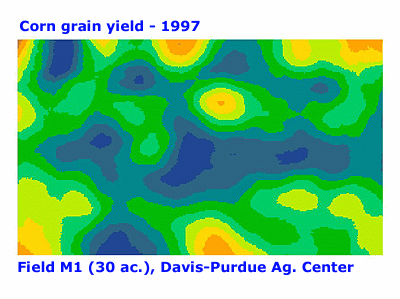Variable: adj: 1 a: able or apt to vary: subject to variation or changes b: fickle, inconstant 2: characterized by variations. (Merriam Webster's Collegiate Dictionary [10th ed.])
![]() he topic for discussion at the weekly gathering of the
Precision Farmers Coffee Club (PFCC) uptown at the Lantern Café this
past Friday had to do with the frustrations that some of the members were
having regarding yield maps that seemed to be illustrating different patterns
of yield variability from year to year in the same field. Some have been
mapping yield for some time now, but the low-yielding spots and high-yielding
spots have not been occurring in the same spots every year.
he topic for discussion at the weekly gathering of the
Precision Farmers Coffee Club (PFCC) uptown at the Lantern Café this
past Friday had to do with the frustrations that some of the members were
having regarding yield maps that seemed to be illustrating different patterns
of yield variability from year to year in the same field. Some have been
mapping yield for some time now, but the low-yielding spots and high-yielding
spots have not been occurring in the same spots every year.
Figure 1. Example of inconsistent variability for corn grain yield from year to year. Common yield color legend for both images.


Needless to say, this inconsistent pattern of yield variability throughout a field puts a damper on the use of such information to plan future management strategies. The upshot of the PFCC discussion at the Lantern Café was that yield variability in a field needs to be consistent from year to year in order for precision farming strategies to be developed to address that variability. But, the term "consistent variability" seems to be an oxymoron. What gives?
A couple of articles were published in agricultural research journals in recent years that support the observations of these early adopters of yield monitoring technology. Research led by John Lamb (jlamb@soils.umn.edu) at the University of Minnesota (Lamb, et al. 1997. Spatial and Temporal Stability of Corn Grain Yields. J. Prod. Ag. 10:410-414) supports the notion that spatial (field position) variability in corn grain yield is not consistent from year to year. Yields within a 4.4 acre research area varied considerably each year of a 5-year study (high - low differences ranged from 44 to 72 bushels per acre during the five years), but were not spatially consistent from year to year. What this means is that historical yield data from a particular spot in the field could not predict future yields in that same spot very reliably.
Another recently reported study (Eghball & Varvel. 1997. Fractal Analysis of Temporal Yield Variability of Crop Sequences: Implications for Site-Specific Management. Agron. J. 89:851-855) offered similar evidence that temporal variability (variability over time) in yields of several crops was more important than spatial variability. The data for their analyses were generated from a long-term cropping systems study involving seven crop rotations evaluated during the years 1975 - 1995 in eastern Nebraska.
Eghball (beghball@unlinfo.unl.edu) and Varvel stated "In this study, which included cropping systems, spatial variability was not reflected in grain yields, because temporal variability was the overriding factor. Spatial differences across blocks [of the study] had little effect on variability of grain yield." The authors conclude by stating "It may also imply that, under rainfed conditions, site-specific management practices are likely to produce highly variable results from year to year, which would still cause problems for interpretation of yield maps."
If you are frustrated with the inconsistent variability demonstrated by multiple-year yield maps, there is good reason. What the guys uptown at the Lantern Café are experiencing is the result of weather (climate) patterns interacting with other yield limiting factors. The most intuitive example of such an interaction is that piece of wet ground that yields with the best of them in a somewhat dry year, but drowns out in a rainy year. Ditto, but reversed, for that piece of sandy ground.
Perennially-occurring yield limiting factors (e.g., soil pH) can be easily identified and managed with site-specific technology simply because they exist every year in pretty much the same areas of a field. However, site-specific technology will help identify sporadic yield limiting factors when they occur, but not necessarily prevent their reoccurrence since one cannot reliably predict the timing of their reoccurrence.